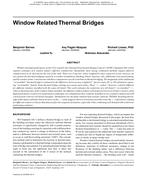Description
Window thermal performance in the US is rated by the National Fenestration Rating Council's (NFRC) Standard 100, which requires estimates of a window frame's effective conductivity. Meanwhile, most energy estimation methods require effective conductivities to be derived for the rest of the wall. These two U-factors, when weighted by their respective areas, however, do not capture the thermal bridging caused by a window installation; flashing, lintels, masonry sills, additional structural framing, and the window frame's interaction with these components can all contribute to thermal bridging.Themagnitude of this additional “as installed” thermal bridge is estimated as the difference between area weightedU–factors and a 2D or 3D simulation capturing “as installed” details. Some thermal bridge catalogs now report such values. These “psi -values,” however, could be different for different windows installed with the same sill detail. This work estimates the sensitivity of a sill detail's “as installed” – value to the properties of the window frame installed. Six different window frames with progressively lower frame U-factors, from high performance wood to low performance aluminum, are simulated as they would be installed in two common commercial wall constructions with two sill detail strategies. Simulations use the finite-element heat transfer software THERM. Resulting knowledge of the impact of frame characteristics on the psi-value suggests that it is not always possible to use the psi-value froma catalog if a different window is chosen than that used for the original calculation, especially when combining well-detailed sills with lower performing windows.
Presented at Thermal Performance of Exterior Envelopes of Whole Buildings XII, December 2013
Citation: Thermal Performance of Exterior Envelopes of Whole Buildings XII
Product Details
- Published:
- 2013
- Number of Pages:
- 12
- File Size:
- 1 file , 5.2 MB
- Product Code(s):
- D-BldConf13-37
